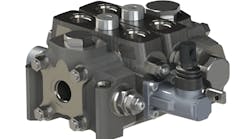Targeting for applications with system pressure to 4,000 psi and backpressure to 290 psi, the V250 directional control valve has an iron housing and hard chrome and nickel-plated spools to resist wear. Thanks to its internal core design, flow rates can range from 65 to 75 gpm and pressure drops are reduced to a minimum. Customization is possible with different spool, control, and positioner options. The V250 is manufactured with precision machining to maintain low internal spool leakages and allow oil viscosity between 60 to 1360 SUS. Work sections are pre-assembled and tested before shipping.
MUNCIE POWER PRODUCTS, (800) 367-7867

